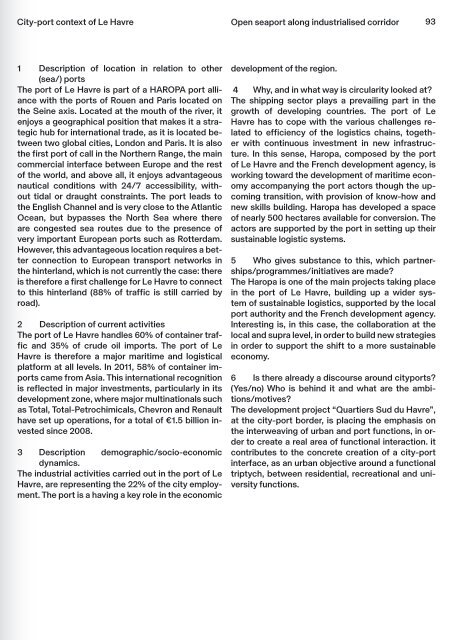Circular City Ports - Workbook
Create successful ePaper yourself
Turn your PDF publications into a flip-book with our unique Google optimized e-Paper software.
<strong>City</strong>-port context of Le Havre<br />
Open seaport along industrialised corridor<br />
93<br />
1 Description of location in relation to other<br />
(sea/) ports<br />
The port of Le Havre is part of a HAROPA port alliance<br />
with the ports of Rouen and Paris located on<br />
the Seine axis. Located at the mouth of the river, it<br />
enjoys a geographical position that makes it a strategic<br />
hub for international trade, as it is located between<br />
two global cities, London and Paris. It is also<br />
the first port of call in the Northern Range, the main<br />
commercial interface between Europe and the rest<br />
of the world, and above all, it enjoys advantageous<br />
nautical conditions with 24/7 accessibility, without<br />
tidal or draught constraints. The port leads to<br />
the English Channel and is very close to the Atlantic<br />
Ocean, but bypasses the North Sea where there<br />
are congested sea routes due to the presence of<br />
very important European ports such as Rotterdam.<br />
However, this advantageous location requires a better<br />
connection to European transport networks in<br />
the hinterland, which is not currently the case: there<br />
is therefore a first challenge for Le Havre to connect<br />
to this hinterland (88% of traffic is still carried by<br />
road).<br />
2 Description of current activities<br />
The port of Le Havre handles 60% of container traffic<br />
and 35% of crude oil imports. The port of Le<br />
Havre is therefore a major maritime and logistical<br />
platform at all levels. In 2011, 58% of container imports<br />
came from Asia. This international recognition<br />
is reflected in major investments, particularly in its<br />
development zone, where major multinationals such<br />
as Total, Total-Petrochimicals, Chevron and Renault<br />
have set up operations, for a total of €1.5 billion invested<br />
since 2008.<br />
3 Description demographic/socio-economic<br />
dynamics.<br />
The industrial activities carried out in the port of Le<br />
Havre, are representing the 22% of the city employment.<br />
The port is a having a key role in the economic<br />
development of the region.<br />
4 Why, and in what way is circularity looked at?<br />
The shipping sector plays a prevailing part in the<br />
growth of developing countries. The port of Le<br />
Havre has to cope with the various challenges related<br />
to efficiency of the logistics chains, together<br />
with continuous investment in new infrastructure.<br />
In this sense, Haropa, composed by the port<br />
of Le Havre and the French development agency, is<br />
working toward the development of maritime economy<br />
accompanying the port actors though the upcoming<br />
transition, with provision of know-how and<br />
new skills building. Haropa has developed a space<br />
of nearly 500 hectares available for conversion. The<br />
actors are supported by the port in setting up their<br />
sustainable logistic systems.<br />
5 Who gives substance to this, which partnerships/programmes/initiatives<br />
are made?<br />
The Haropa is one of the main projects taking place<br />
in the port of Le Havre, building up a wider system<br />
of sustainable logistics, supported by the local<br />
port authority and the French development agency.<br />
Interesting is, in this case, the collaboration at the<br />
local and supra level, in order to build new strategies<br />
in order to support the shift to a more sustainable<br />
economy.<br />
6 Is there already a discourse around cityports?<br />
(Yes/no) Who is behind it and what are the ambitions/motives?<br />
The development project “Quartiers Sud du Havre”,<br />
at the city-port border, is placing the emphasis on<br />
the interweaving of urban and port functions, in order<br />
to create a real area of functional interaction. it<br />
contributes to the concrete creation of a city-port<br />
interface, as an urban objective around a functional<br />
triptych, between residential, recreational and university<br />
functions.


















